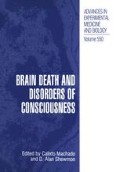Abstract
Brain death is the colloquial term describing the determination of human death based upon showing the irreversible cessation of all clinical brain functions. Although the term brain death is potentially misleading because it suggests that there are different types of death, or that it is only the brain that is dead in such cases, it is the term that remains universally used and I will use it here.
Access this chapter
Tax calculation will be finalised at checkout
Purchases are for personal use only
Preview
Unable to display preview. Download preview PDF.
References
Appendix F, in: President’s Commission for the Study of Ethical Problems in Medicine and Biomedical and Behavioral Research. Defining Death. Medical, Ethical, and Legal Issues in the Determination of Death. Washington, DC: US Govemment Printing Office, 1981.
Bemat JL. A defense of the whole-brain definition of death. Hastings Cent Rep 1998; 28 (2): 14–23.
Bernat JL. The biophilosophical basis of whole-brain death. Soc Philos Policy 2002; 19 (2): 324–342.
Collaborative Study of Cerebral Survival, An appraisal of the criteria of cerebral death. JAMA 1977; 237: 982–986.
Earnest MP, Beresford HR, McIntyre HB. Testing for apnea in brain death: methods used by 129 clinicians. Neurology 1986; 36: 542–544.
Mejia RE, Pollack MM. Variability in brain death determination practices in children. JAMA 1995; 274: 550–553.
Wijdicks EFM. Determining brain death in adults. Neurology 1995; 45: 1003–1011.
The Quality Standards Subcommittee of the American Academy of Neurology, Practice parameters for determining brain death in adults [summary statement]. Neurology 1995; 45: 1012–1014.
Wang MY, Wallace P, Gruen JB. Brain death documentation: analyisis and issues. Neurosurgery 1998; 51: 731–735.
Shewmon DA. Chronic “brain death:” meta-analysis and conceptual consequences. Neurology 1998; 51: 1538–1545.
Cole DJ. The reversibility of death, JMed Ethics 1992; 18: 26–30.
Lynn L Cranford R. The persisting perplexities in the determination of death, In: Youngner SJ, Arnold RM, Schapiro R, eds. The Definition of Death: Contemporary Controversies. Baltimore: Johns Hopkins University Press,1999.
Ivan LP. Time sequence in brain death, In: Morley TP, ed. Moral, Ethical, and Legal Issues in the Neurosciences. Springfield, IL: Charles C. Thomas, 1981.
Miyamoto O, Auer RN. Hypoxia, hyperoxia, ischemia, and brain necrosis. Neurology 2000; 54: 362–371.
Plum F, Posner JB. The Diagnosis of Stupor and Coma. 3rd ed. Philadelphia: F. A. Davis Co., 1980: 87151.
Schroder R. Later changes in brain death: signs of partial recirculation. Acta Neuropathol (Berl) 1983; 62: 15–23.
Walker AE, Diamond EL, Moseley J. The neuropathological findings in irreversible coma: a critique of the “respirator brain.” JNeuropathol Exp Neurol 1975; 34: 295–323.
Coimbra CG. Implications of ischemic penumbra for the diagnosis of brain death. Brazil J Med Biol Res 1999; 32: 1479–1487.
Bradac GB, Simon. RS. Angiography in brain death. Neuroradiology 1974; 7: 25–28.
Goodman JM, Heck LL, Moore B. Confirmation of brain death with portable isotope angiography: a review of 204 consecutive cases. Neurosurgery 1985; 16: 492–497.
Petty GW, Mohr JP, Pedley TA, et al. The role of transcranial Doppler in confirming brain death: sensitivity, specificity, and suggestions for performance and interpretation. Neurology 1990; 40: 300–303.
Ducrocq X, Braun M, Debouverie M, Junges C, Hummer M, Vespignani H. Brain death and transcranial Doppler: experience in 130 cases of brain dead patients. JNeurol Sci 1998; 160: 41–46.
Wilson K, Gordon L, Selby Jr. JB. The diagnosis of brain death with Tc-99m HMPAO. Clin Nucl Med 1993; 18: 428–434.
Donohoe KJ, Frey KA, Gerbaudo VH, Mariani G, Nagel JS, Shulkin B. Procedural guidelines for brain death scintigraphy. JNucl Med 2003; 44: 846–851.
Lovblad KO, Bassetti C. Diffusion-weighted magnetic resonance imaging in brain death. Stroke 2000; 31: 539–542.
Karantanas AH, Hadijigeorgion GM, Paterakis K, Sfiras D, Komnos A. Contributions of MRI and MR angiography in early diagnosis of brain death. Eur Radiology 2002; 12: 2710–2716.
Darby JM,Yonas H, Gur D, Latchaw RE. Xenon-enhanced computed tomography in brain death. Arch Neuro11987; 44: 551–554.
Bernat JL, Culver CM, Gert B. On the definition and criterion of death. Ann Intern Med 1981; 94: 389–394.
Pallis C. ABC of Brainstem Death. 2nd ed. London: British Medical Journal Publishers, 1997.
Bernat JL. How much of the brain must die in brain death? J Clin Ethics 1992; 3: 21–26.
Kosteljanetz M, Ohrstrom JK, Skjodt S, Teglbjaerg PS. Clinical brain death with preserved cerebral arterial circulation. Acta Neurol Scand 1988;78:418–421.
Ferbert A, Buchner H, Ringelstein EB, et al, Isolated brainstem death. Electroencephalogr Clin Neurophysiol 1986; 65: 157–160.
Author information
Authors and Affiliations
Editor information
Editors and Affiliations
Rights and permissions
Copyright information
© 2004 Springer Science+Business Media New York
About this paper
Cite this paper
Bernat, J.L. (2004). On Irreversibility as a Prerequisite for Brain Death Determination. In: Machado, C., Shewmon, D.A. (eds) Brain Death and Disorders of Consciousness. Advances in Experimental Medicine and Biology, vol 550. Springer, Boston, MA. https://doi.org/10.1007/978-0-306-48526-8_14
Download citation
DOI: https://doi.org/10.1007/978-0-306-48526-8_14
Publisher Name: Springer, Boston, MA
Print ISBN: 978-1-4757-0976-6
Online ISBN: 978-0-306-48526-8
eBook Packages: Springer Book Archive

